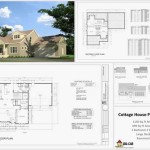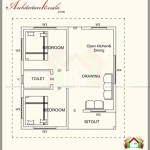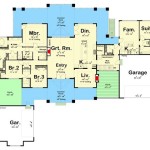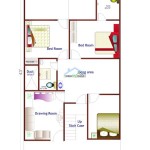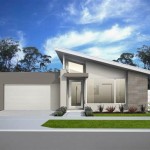House Plans With Drive-Under Garage: A Comprehensive Guide
House plans with drive-under garages, also known as tuck-under garages, provide a unique solution for homeowners navigating challenging terrains, seeking cost-effective space maximization, or desiring a specific aesthetic. These designs integrate the garage directly into the foundation of the house, typically at the basement or ground level, allowing vehicles to be parked beneath the main living areas. This arrangement offers several advantages, but also presents particular considerations that must be addressed during the planning and construction phases. This article will delve into various aspects of house plans with drive-under garages, covering their benefits, design considerations, structural requirements, and potential drawbacks.
The core concept revolves around leveraging the topography of the lot to create convenient access to the garage without sacrificing living space. This is particularly relevant for properties situated on slopes or hillsides where a conventional attached garage might require extensive excavation and retaining walls. In essence, the drive-under garage becomes an integral part of the foundation, providing protection from the elements and simplifying access between the vehicle and the home's interior.
Advantages of Drive-Under Garages
One of the most compelling advantages of drive-under garages is their effective use of space. On smaller lots, where footprint restrictions limit the size of the dwelling, integrating the garage into the foundation allows for a larger living area on the upper floors. This is achieved by eliminating the need for a separate detached garage or a large attached structure that encroaches upon valuable yard space. The space saved can be repurposed for gardens, patios, or other outdoor amenities.
Furthermore, drive-under garages can offer enhanced security. Direct access from the garage into the home minimizes exposure to the outside elements and potential threats. This is especially beneficial during inclement weather or in areas with high crime rates. The enclosed nature of the garage also provides better protection for vehicles and stored items from theft and vandalism.
Cost savings can also be a significant factor in favor of drive-under garages, particularly on sloped lots. The excavation required for a conventional garage on a steep slope can be substantial, adding significantly to the overall construction cost. A drive-under garage, on the other hand, utilizes the existing slope, potentially reducing the amount of earthmoving needed and minimizing the need for extensive retaining walls. However, this cost advantage is dependent on a thorough site assessment and careful design considerations.
Aesthetically, drive-under garages can enhance the appearance of a home. By integrating the garage seamlessly into the foundation, the overall design can be streamlined and more visually appealing. Architects can use the grade change to create interesting architectural features, such as walk-out basements or multilevel decks, that complement the surrounding landscape. The reduced visual impact of the garage can also improve the curb appeal of the property.
Key Design and Structural Considerations
Designing a house with a drive-under garage necessitates careful attention to several key structural and design elements. Proper drainage is paramount to prevent water damage and ensure the longevity of the foundation. The slope of the driveway must be carefully calculated to allow for safe and easy vehicle access, especially during winter months in colder climates. Adequate ventilation within the garage is also crucial to prevent the build-up of fumes and moisture, which can lead to health problems and structural deterioration.
The foundation walls of a drive-under garage must be designed to withstand the lateral pressure of the surrounding soil. This typically requires reinforced concrete walls that are properly waterproofed to prevent water infiltration. The floor slab of the garage must also be strong enough to support the weight of vehicles and other stored items. Soil testing is essential to determine the soil's bearing capacity and to ensure that the foundation is adequately designed to support the load.
The structural support for the living space above the garage must be carefully engineered. This typically involves the use of beams and columns to transfer the load from the upper floors to the foundation walls. The design must account for both static loads (the weight of the building materials) and dynamic loads (the weight of occupants and furniture). Seismic considerations are also important in earthquake-prone areas, requiring additional reinforcement to resist lateral forces.
Accessibility is another important design consideration. Ramps or stairs must be provided to connect the garage to the living area. The design should comply with local building codes and accessibility standards, ensuring that the garage is accessible to people with disabilities. The layout of the garage should also be carefully planned to maximize space and allow for easy maneuvering of vehicles.
Furthermore, fire safety is a critical concern. The garage should be separated from the living area by a fire-rated wall and door to prevent the spread of fire and smoke. Smoke detectors and carbon monoxide detectors should be installed in the garage and the adjacent living area to provide early warning in case of a fire or carbon monoxide leak. Proper ventilation is also important to prevent the accumulation of flammable fumes.
Potential Drawbacks and Mitigation Strategies
While drive-under garages offer numerous advantages, they also present some potential drawbacks that must be addressed during the planning and design stages. One common concern is the increased risk of moisture problems. Because the garage is partially or fully underground, it is more susceptible to water infiltration, especially in areas with high water tables or poor drainage. This can lead to mold growth, structural damage, and health problems.
To mitigate this risk, proper waterproofing is essential. This includes applying a waterproof membrane to the exterior of the foundation walls, installing a drainage system to collect and divert water away from the foundation, and ensuring that the ground around the garage slopes away from the building. A sump pump may also be necessary to remove any water that accumulates in the garage.
Another potential drawback is the lack of natural light and ventilation. Because the garage is partially or fully underground, it may receive little or no natural light. This can make the garage feel dark and claustrophobic. Poor ventilation can also lead to the build-up of fumes and moisture, which can be harmful to health.
To address this issue, consider incorporating windows or skylights into the garage design. This will allow natural light to enter the space and improve ventilation. Mechanical ventilation systems, such as exhaust fans, can also be installed to remove fumes and moisture. It's important to regularly inspect and maintain these systems to ensure they are functioning properly.
Noise transmission can also be a concern, especially if the living area is located directly above the garage. The noise of vehicles entering and exiting the garage can be disruptive to the occupants of the house. This can be mitigated by using soundproofing materials in the floor and walls of the garage. Insulation, resilient channels, and sound-dampening drywall can all help to reduce noise transmission.
Finally, the construction of a drive-under garage can be more complex and challenging than a conventional garage. This requires experienced contractors and careful attention to detail. It's important to hire qualified professionals who have experience in building drive-under garages and who are familiar with local building codes and regulations. A thorough site investigation and geotechnical analysis are also essential to ensure that the foundation is properly designed and constructed.
In summary, house plans with drive-under garages represent a valuable design option with distinct benefits and challenges. Proper planning, design, and construction are crucial to maximizing the advantages and mitigating the potential drawbacks. By carefully considering the factors outlined in this article, homeowners can create a functional, aesthetically pleasing, and structurally sound home with a drive-under garage that meets their needs and enhances their property value.

Drive Under House Plans With Basement Garage The Designers

Hillside House Plans With Garages Underneath Houseplans Blog Com

Drive Under House Plans

4 Bedroom Contemporary Drive Under Style House Plan 4742

Plan 23270jd Narrow Craftsman With Drive Under Garage Lot House Plans

3 Bedroom Split Level House Plan With Drive Under Garage

Plan 69649am Northwest House With Drive Under Garage Sloping Lot Plans

Contemporary House Plan For Narrow Lot With Drive Under Garage

Drive Under House Plans Sater Design Collection

Drive Under Garage Home Plans House And More


